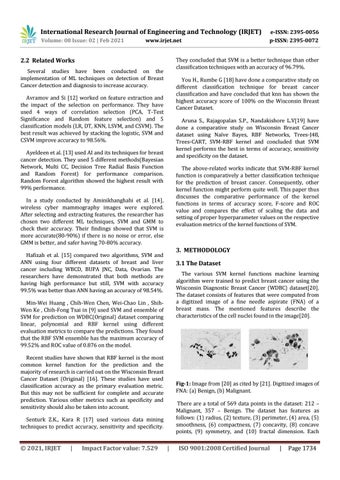International Research Journal of Engineering and Technology (IRJET)
e-ISSN: 2395-0056
Volume: 08 Issue: 02 | Feb 2021
p-ISSN: 2395-0072
www.irjet.net
2.2 Related Works
They concluded that SVM is a better technique than other classification techniques with an accuracy of 96.79%.
Several studies have been conducted on the implementation of ML techniques on detection of Breast Cancer detection and diagnosis to increase accuracy.
You H., Rumbe G [18] have done a comparative study on different classification technique for breast cancer classification and have concluded that knn has shown the highest accuracy score of 100% on the Wisconsin Breast Cancer Dataset.
Avramov and Si [12] worked on feature extraction and the impact of the selection on performance. They have used 4 ways of correlation selection (PCA, T-Test Significance and Random feature selection) and 5 classification models (LR, DT, KNN, LSVM, and CSVM). The best result was achieved by stacking the logistic, SVM and CSVM improve accuracy to 98.56%.
Aruna S., Rajagopalan S.P., Nandakishore L.V[19] have done a comparative study on Wisconsin Breast Cancer dataset using Naïve Bayes, RBF Networks, Trees-J48, Trees-CART, SVM-RBF kernel and concluded that SVM kernel performs the best in terms of accuracy, sensitivity and specificity on the dataset.
Ayeldeen et al. [13] used AI and its techniques for breast cancer detection. They used 5 different methods(Bayesian Network, Multi CC, Decision Tree Radial Basis Function and Random Forest) for performance comparison. Random Forest algorithm showed the highest result with 99% performance.
The above-related works indicate that SVM-RBF kernel function is comparatively a better classification technique for the prediction of breast cancer. Consequently, other kernel function might perform quite well. This paper thus discusses the comparative performance of the kernel functions in terms of accuracy score, F-score and ROC value and compares the effect of scaling the data and setting of proper hyperparameter values on the respective evaluation metrics of the kernel functions of SVM.
In a study conducted by Aminikhanghahi et al. [14], wireless cyber mammography images were explored. After selecting and extracting features, the researcher has chosen two different ML techniques, SVM and GMM to check their accuracy. Their findings showed that SVM is more accurate(80-90%) if there is no noise or error, else GMM is better, and safer having 70-80% accuracy.
3. METHODOLOGY
Hafizah et al. [15] compared two algorithms, SVM and ANN using four different datasets of breast and liver cancer including WBCD, BUPA JNC, Data, Ovarian. The researchers have demonstrated that both methods are having high performance but still, SVM with accuracy 99.5% was better than ANN having an accuracy of 98.54%.
3.1 The Dataset The various SVM kernel functions machine learning algorithm were trained to predict breast cancer using the Wisconsin Diagnostic Breast Cancer (WDBC) dataset[20]. The dataset consists of features that were computed from a digitized image of a fine needle aspirate (FNA) of a breast mass. The mentioned features describe the characteristics of the cell nuclei found in the image[20].
Min-Wei Huang , Chih-Wen Chen, Wei-Chao Lin , ShihWen Ke , Chih-Fong Tsai in [9] used SVM and ensemble of SVM for prediction on WDBC(Original) dataset comparing linear, polynomial and RBF kernel using different evaluation metrics to compare the predictions. They found that the RBF SVM ensemble has the maximum accuracy of 99.52% and ROC value of 0.876 on the model. Recent studies have shown that RBF kernel is the most common kernel function for the prediction and the majority of research is carried out on the Wisconsin Breast Cancer Dataset (Original) [16]. These studies have used classification accuracy as the primary evaluation metric. But this may not be sufficient for complete and accurate prediction. Various other metrics such as specificity and sensitivity should also be taken into account.
Fig-1: Image from [20] as cited by [21]. Digitized images of FNA: (a) Benign, (b) Malignant. There are a total of 569 data points in the dataset: 212 – Malignant, 357 – Benign. The dataset has features as follows: (1) radius, (2) texture, (3) perimeter, (4) area, (5) smoothness, (6) compactness, (7) concavity, (8) concave points, (9) symmetry, and (10) fractal dimension. Each
Senturk Z.K., Kara R [17] used various data mining techniques to predict accuracy, sensitivity and specificity.
© 2021, IRJET
|
Impact Factor value: 7.529
|
ISO 9001:2008 Certified Journal
|
Page 1734


